| Day 6 Dunhuang ( B,L ) |
| Sightseeing also included the Hecang Fortress, which supplies like food and wine were tranported here from nearby towns to be stored for the armies that guarded the Yumen Guan Pass. Drive to Dunhang for one hour in the late afternoon. Stay overnight in Dunhuang. |
Yangguan Pass Museum | Yang Pass (Yangguan), also known as the Southern Pass, sits 75 kilometers southwest of Dunhuang, and was originally built by Emperor Wu in Hang Dynasty as one of the two most important passes protecting Dunhuang from invasion from the west (the other pass is Yumen Pass). | Yumenguan Pass | Yumenguan Pass, located on a hillock 90 kms northwest of Dunhuang city, used to be one of the two critical defensive passes protecting Dunhuang from invasion from the West about two thousand years ago. |
|
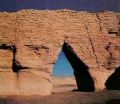 |
| [ Optional ] Dunhuang: In history, Dunhuang was an important town on the ancient Silk Road. Its greatest significance lies in its unique grottoes, located among a wilderness of yellow sands. Researchers say there are 735 grottoes in all, with the Mogao Grottoes providing a representative example. These caves were cut into a cliff 25 kilometers southeast of Dunhuang. |
|
| Day 7 Dunhuang ( B,L ) |
| After a whole day tour in Dunhuang, you will take an overnight train (soft sleeper) to another "Pearl on the Silk Road" - Turpan. Stay overnight on the train. Train No.: Y951 (2018-0704) (leave Dunhuang at 20h18, arrive Turpan at 07h04 next day) |
Crescent Moon Spring & Mingsha Mountain | Crescent Moon Spring is 6km south of Dunhuang in the Singing Sands Mountains and is quite literally an oasis in the desert. The Spring's name derives from the crescent moon shape the small pool of spring water has taken between two large sand dunes. Although the area is very dry, the pool doesn't dr…… | White Horse Tower | White House Tower has 9 layers and 12 meters high with a diameter of 7 meters. It has a style octagon; wrapped whith the bricks, the first face is three meters of breadth, the second to the fourth layer present to fold the heavy form of cape. | Mogao Grottoes | The Mogao Grottoes (Mogao Ku) also known as the Thousand Buddha Caves, constitute one of the three major Buddhist grotto sites in China. It is one of three noted grottoes in China and also the largest, best preserved and richest treasure house of Buddhist art in the world. |
|
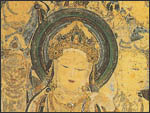 |
| [ Optional ] Train Y951 from Dunhuang to Turpan: Take a train from Liuyuan Railway Station (138km, 2.5 hours driving) to Turpan. Train No.: Y951 (2018-0704) (leave Dunhuang at 20h18, arrive Turpan at 07h04 next day), stay overnight on the train. The best train ticket is a soft sleeper ticket. |
|
| Day 8 Turpan ( B,L ) |
| Upon arrival at Turpan railway station, pickup by our English speaking tour guide and drive to hotel to freshup and have breakfast. Afterward drive to take our visiting in Turpan. |
Emin Minaret | It is designed in a simple Afghani style and was built in 1777 AD by a local ruler in order to show the impressive memories of his father's contribution to Qing government. | Ancient City of Jiaohe | The Ancient City of Jiaohe is situated at Yar Town, 13 km west of Turpan City. It was first the capital of the State of South Cheshi, which was one of the 36 kingdoms in the Western Region. | Astana Graves | To the northwest of the Gaochang Ruins lies the Astana Graves (Asitana Gumuqun), where the dead of Gaochang were buried. Astana means "capital" in Uygur and Karakhoja is the name of a legendary hero of the ancient Uygur Kingdom who removed the evils from the people by killing a vicious dragon. | Bezeklik Thousand Buddha Caves | Bezeklik Thousand-Buddha Caves is situated at the north bank of Muzat River in Turpan, a collection of retreats once inhabited by Buddhist monks, as well as the imperial monasteries for local emperor during the Gaochang Kingdom and Tang Dynasty. |
|
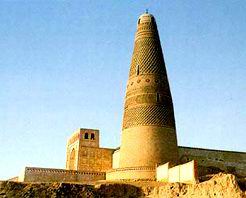 |
| [ Optional ] Turpan-style food: Turpan-style food is tea with home-baked bread, Pamirdin, kebab, and fruit. Pamirdin is a type of pie, contains lamb, carrots and onion. kebab is served wrapped in bread with a salad and a dressing, it includes grilled, roasted, and stewed dishes of large or small cuts of meat, The traditional meat for kebab is lamb. |
|
| Day 9 Turpan, Urumqi ( B,L ) |
| Morning tour in Turpan.Drive drive 90 minutes to Urumqi. The distance is 200 KM. You may enjoy the view of Ghobi Dessort on the way. Free tim at International Grand Bazaar in the evening. |
Aiding Lake | Aydingkol Lake (Aiding Hu, in Chinese), 50 kilometers (about 31 miles) from Turpan City, is at the bottom of the deepest depression in China's land mass, known as Turpan Pendi. | Karez well | These underground channels rate as one of ancient China's greatest public works projects as the Great Wall and the Grand Canal. The city of Turpan owes its existence to these vital wells and channels, some of which were constructed over 2000 years ago. | Flaming Mountain | Flaming Mountains are situated in the north of Turpan Basin. It were made famous in Chinese literature by the classic novel Journey to the West. The story is about the monk Xuan Zang and his followers who traveled west in search of the Buddhist sutra. The mountains seem to be on fire in the burning …… |
|
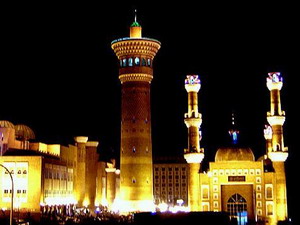 |
| [ Optional ] International Grand Bazaar: In Urumqi, a bazaar is more than just a place to buy things. It offers locals a place to enjoy the flavour of a festival, to have a rest and to meet with friends. People barter goods, exchange information, and even gossip at the bazaar market. |
|
| Day 10 Urumqi, Kashgar ( B,L ) |
| Visit Xinjiang Museum and Red Hill. Later today you will be transferred to Urumqi airport, you'll fly to Kashgar, an oasis city still evocative of its long period as a key port of call on the Silk Road. Free time for the rest of the day in Kashgar. Recommend you to walk around the old town of Kashgar. |
Xinjiang Museum | As an important place of Xinjiang Region, you can get a whole view of different folklore and customs about 12 ethnic minorities in the area, in the other hand, more than 10,000 culture relics displayed inside exclude some 11 natural corpses that preserved very well. | Red Hill | The Red Hill stands magnificently at the center of Urumqi City. At sunrise and sunset, the hill looks red for it reflects the red light from the sun, so it was named Red Hill. The views from the top of the mountain of the surrounding countryside and breathtaking mountains. | Kashi | Kashgar (or Kashi) is situated in the southwest of Xinjiang. From the west, this is the first point of arrival on land routes from Pakistan and Kirgyzistan. Long a vital stop on the Silk Road, this remote city some 4000 km from Beijing, used to take up to six months to reach from the capital. |
|
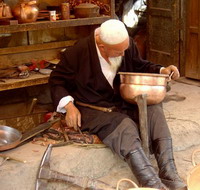 |
| [ Optional ] Old town of Kashgar: The Old Town surrounds the center of Kashgar, with the Id Kah Mosque rising at its center. Use the north-south thoroughfare of Jiefang Lu to orient yourself and then head east or west into the thick of things. |
|